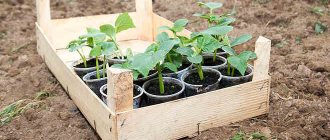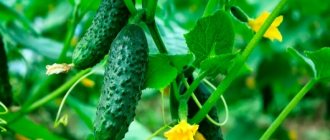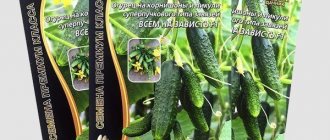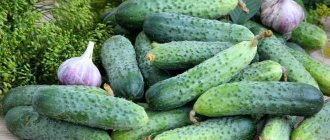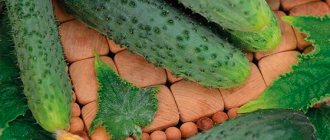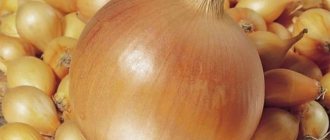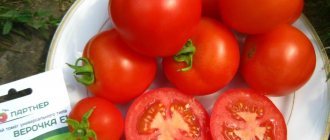Cucumbers, the envy of everyone, are a hybrid (as indicated by the F1 inscription), so it is not possible to obtain high-quality seeds from such crops at home. It belongs to the Premium class, is distinguished by high yield and excellent taste, versatility of use and cultivation (in the open ground, in a greenhouse, barrels, containers, etc.).
Cucumber seeds “The envy of everyone”
Ripening of cucumbers “The envy of everyone”
Cucumbers “Envy of Everyone” give a good harvest
Description of the hybrid
Being a first-born hybrid. Cucumbers, to the envy of everyone, have absorbed the best quality characteristics of their “parents”. The cucumber is parthenocarpic, so it pollinates on its own. Consequently, it does not require pollination by insects, which speeds up and increases fruiting. At the same time, the seeds do not have time to ripen, due to which the fruits have a perfectly smooth surface and do not yellow or overripe. This same characteristic allows you to transport the crop over long distances and store cucumbers for a long time.
Other features:
- According to the type of flowering, it is female, and this indicates that all flowers have full-fledged ovaries.
- Branching is self-regulating, so forming a bush is not necessary, but it is desirable to increase productivity.
- The type of growth is bunched, which indicates a well-developed central stem and the absence of lateral shoots.
- Fruiting is quite long - from June to October.
- The hybrid easily tolerates the lack of sunlight, so the bushes can be planted in the shade.
Appearance of cucumbers
The fruits have the following characteristics:
- the minimum length is 8 cm, the maximum is 12;
- average weight varies from 80 to 100 grams;
- color – rich bright green;
- stripes of light shades run along the sides;
- surface – finely tuberculate;
- whitish fluff is present;
- spines - sparse and large;
- pulp - crispy, compacted, juicy;
- The aroma is pronounced cucumber.
Productivity
The bunch arrangement of fruits in the nodes guarantees the highest level of productivity. One ovary can contain from 3 to 6, and sometimes more, gherkins.
The level of fruiting depends on the conditions of detention and climate, but on average it can be obtained from 1 square. m 10 kg of fruit.
Advantages and disadvantages
The positive aspects of cucumbers are the envy of everyone:
- excellent yield;
- duration of fruiting;
- transportability;
- excellent taste;
- preservation of crunch and elasticity after heat treatment;
- commercial appearance;
- keeping quality;
- versatility of use (salting, canning, pickling, fresh consumption);
- lack of bitterness;
- the ability to grow in different ways and under different conditions, even in a room;
- disease resistance;
- quick adaptation to any temperature conditions;
- stability of fruiting.
Negative aspects of this cucumber hybrid:
- relatively high cost of seed material;
- the need to purchase new seeds every year, since it is impossible to get them at home.
Characteristics
Since hybrid varieties do not require pollination, “Everyone's Envy” feels good both in greenhouses and in the open air.
The hybrid is resistant to sudden temperature changes. The side shoots of the plant can grow extremely strongly. Each node can form 3-6 ovaries.
The variety is resistant to major diseases that can affect cucumbers. Thanks to this feature, it does not require additional treatment with chemicals.
Important! The productivity of “The Envy of Everyone” does not depend on the conditions of care. During the season you can collect about ten kg of fruits
The fruits are dark green in color with white stripes that are located along the entire length of the vegetable. The shape is smooth, the flesh is dense with a characteristic crunch. They have good taste.
Advantages:
- do not require pollination;
- have excellent taste;
- excellent presentation;
- have good yield indicators that do not depend on growing conditions;
- universal use of fruits;
- long shelf life;
- tolerate transportation well;
- no bitterness;
- They are even suitable for growing on a windowsill in an apartment.
Growing seedlings
It is possible to grow cucumbers to the envy of everyone using the seedless method, which saves time and effort. However, the seedling method allows you to get the first harvest much earlier. Sowing seeds should begin after the 20th of March or at the beginning of April.
Seed preparation
The first thing to do is to thoroughly warm the seed material 10-14 days before planting. Different methods are used for this:
- spread the grains out into the open rays of the sun;
- place the seeds in a fabric bag, which is placed near the heating device (heating radiator, stove, etc.);
- pour the seeds into a thermos, add hot water (not boiling water), let it warm up for 2 hours.
The temperature when heating the seed material should be 45-55 degrees. The number of days if a thermos is not used is three days.
Next comes the actual preparation:
- Sorting. It is necessary to manually sort through each grain, removing damaged and weak elements. Then the seeds are dipped in water mixed with table salt and allowed to stand for 15-20 minutes. Seeds unsuitable for planting will float to the surface of the water. The last step is to rinse under running water.
- Disinfection. The procedure is necessary to ensure that future seedlings are not exposed to disease. There are several methods of disinfection - soak for half an hour in a weak solution of manganese (usually 3%), soak in garlic tincture. But many gardeners consider the most effective method to be the use of aloe juice. To do this, you need to cut the leaves of the plant, put it in a dark place for 5 days (temperature 18-20 degrees), and then squeeze out the juice. Seed material is placed in the resulting liquid for a day. Next is washing and drying.
- Treatment to strengthen immunity and stimulate rapid growth. To do this, the seeds are soaked in one of the preparations: Gummi, Epin, Immunocytophyte. If you do not want to use store-bought products, you can use folk recipes. For example, soak for a day in wood ash slurry (1 tablespoon of ash per 1 liter of water). The same method can be used right up to seed pecking.
- Soaking for germination of sprouts. Use warm water - hold the seeds for 20-30 minutes, place on a damp cloth.
If the seeds have hatched, and weather conditions or other circumstances do not allow planting, place the material in the lower part of the refrigerator, where the temperature does not exceed 4 degrees, but does not fall below 3 degrees.
Find out how to germinate cucumber seeds from the video:
Planting, maintenance conditions and care of seedlings
Sprouted seeds are planted in one large container or placed in peat pots. Place the container on the windowsill so that the seedlings receive sunlight.
Rules:
- the depth of planting seed material is one and a half to two centimeters;
- air temperature – 23-25 degrees, ground – 15;
- soil type - earth, sand, peat;
- Before the sprouts emerge, the containers are covered with a thick film, which must be removed during the day for ventilation;
- when the first shoots appear, it is necessary to slightly shade them, otherwise the fragile leaves will get burned;
- watering the sprouts is done every day (the soil should be moist, but not wet);
- when the bushes begin to form, you should water them once every 3 days;
- if side shoots form, they are cut off;
- To accelerate growth, you can feed them with organic matter and minerals.
If natural sunlight and heat are not enough, it is advisable to use fluorescent or other lamps. They are turned on for a period of 12 to 16 hours a day.
Indicators of excellent seedlings that are ready for planting in a permanent place:
- age – 28-35 days;
- height – minimum 25 cm, maximum 30 cm;
- thickness – from 5 to 10 mm;
- number of sheets – 5-6 pieces;
- the distance from the root neck to the cotyledon is 4-5 cm;
- type of stem – strong;
- short internodes;
- absence of foreign odors (pay special attention to rot).
Landing
Soil requirements
The soil must be moist, neutral in acidity, and breathable. Before planting seedlings, organic fertilizer is applied. For this, manure is used (per 1 sq. m. from 10 to 15 kg).
You can prepare the soil in 2 ways:
- In autumn. Digging is carried out and drainage is lined. It consists of straw, grass, branches, etc. The laying depth is 30-40 cm. Next, the layer is compacted and manure is poured on top. It is advisable to cover it with film. In spring, the shelter is removed, after which a layer of earth is poured. This method has a number of advantages: all winter, thanks to manure and film, the soil is kept in warm conditions, so when warmed up, it is completely ready for planting seedlings. In addition, the soil is maximally saturated with nutrients.
- In the spring. As in the previous case, a drainage system is installed. Wood ash and the drug Nitrophoska are poured onto it (per 1 sq. m. 300 grams of the first component and 100 grams of the second). A small amount of manure is scattered and soil is placed on top. Be sure to cover with film and let it brew for 7-10 days.
On such fertile land you can set up a greenhouse for seedlings or plant bushes in a permanent place. In the second case, you will have to cover the seedlings with film for some time to preserve heat.
The envy of everyone is better to plant cucumber after potatoes, tomatoes, cabbage, beets, oats, sweet clover, rye, phacelia, alfalfa, mustard and leeks. It is prohibited to use land after melons and melons.
Transplanting seedlings
Diving into open ground is carried out after May 15th. The process is carried out as follows:
- make holes at a distance of 15 cm from each other, 60 cm between rows, which allows you to get maximum yield;
- remove the seedlings from the container so that a little soil remains on the root system (do not remove from peat pots);
- deepen the bushes into the hole;
- pour warm water;
- cover with soil;
- Attach the seedlings to the support.
Planting seeds in open ground
If you use the seedless method of growing cucumbers, you must adhere to the following rules:
- Prepare the seeds as described above.
- The soil temperature should not be below +15 degrees.
- The distance of the holes for horizontal cultivation is 50 cm, for vertical cultivation (on a trellis) it is only 20-30 cm.
- Up to 5 seeds are placed in one hole.
- The width between rows should be at least 30 cm.
- The depth of planting seed material is a couple of centimeters.
- When the first shoots appear, thinning is carried out. That is, weak elements are removed. At the same time, you cannot pull them out of the ground; you need to carefully cut them at the root with small scissors. This will avoid damage to strong plantings.
- When the first 4 leaves are formed, the apical bud is pinched, which will speed up the process of formation of flowers and ovaries.
- After planting the seeds, the crop is watered with warm water and covered with plastic wrap.
- Subsequently, after the emergence of seedlings, the shelter is removed during the daytime to adapt the plant and ventilate it.
Planting cucumbers “To the envy of everyone” immediately in open ground and for seedlings
Cucumbers of this variety can be planted either by seedlings or without seedlings.
You can plant the seeds of the “Envy of Everyone” cucumbers directly into open ground beds in the garden in the second half of May, and in greenhouses this procedure is carried out a couple of weeks earlier.
When growing cucumber seedlings “To the Envy of Everyone,” sowing is done in the last ten days of March or in the first ten days of April. Moreover, when pre-growing seedlings at home, the first harvest of ripe gherkins can be obtained a couple of weeks earlier than when sowing seeds directly into the ground.
Photo of germination of cucumber seed material
The only thing that vegetable growers usually do is soak cucumber seed material in damp material to germinate it. After they hatch, the cucumber seeds are placed in prepared containers.
Planting seeds
The soil for planting cucumber seeds should be quite loose and nutritious. Usually, a ready-made nutrient substrate is purchased in stores; all the necessary fertilizers for growing cucumber seedlings have already been added to it.
Advice!
Since cucumbers have a very delicate root system, which does not tolerate unnecessary transplants, which often damage the roots, it is therefore recommended to immediately lay out the seed material in separate cups. In this case, there is no need to pick.
The seeds of the “Envy of Everyone” cucumbers are buried in moistened soil to a depth of 1 cm, the cups are covered with film and placed in a bright, dark place until shoots appear. Usually a couple of seeds are planted in each cup. After the shoots appear, the stronger plant is left, and the other one is pinched at soil level.
After the cucumber sprouts appear, the film must be removed and the cups transferred to the windowsill.
Further care of seedlings
The main thing when caring for cucumber seedlings is to follow the watering regime.
The soil in containers should always be moist, but it is important that it does not stagnate
Water for irrigation is preliminarily settled; it must be heated, since cold water negatively affects the seedlings.
During the period of growing cucumber seedlings “Everyone is Envy”, they are fed a couple of times with organic matter (infusion of cow manure) or complex mineral fertilizer. The interval between fertilizing is 12-13 days.
Cucumber seedlings “Envy of Everyone” should be transplanted into open ground at the age of 28-30 days, while the plants should have at least 5-6 true leaves, and the height of the seedlings should be at least 20 cm.
Transplanting cucumber seedlings “To the envy of everyone”
The beds for cucumbers are prepared in advance - humus or compost is added before digging. Immediately before planting, place 1 tbsp in the planting holes. l. superphosphate and potassium salt.
The best predecessors for this hybrid are:
- potato;
- tomatoes;
- cabbage;
- beet;
- oats;
- sweet clover;
- rye;
- phacelia;
- alfalfa;
- mustard;
- leek.
The distance between adjacent holes should be at least 0.15 m, and the row spacing should be about 0.6 m.
When growing cucumbers in peat cups, seedlings are planted with them
. And the seedlings are taken out of the plastic container along with a clod of earth - in this case, the roots of the cucumbers will not be damaged, and the plants will not get sick and will quickly acclimatize to the new place.
Plants are placed in holes, soil is added, compacted and watered. Supports are dug in next to the plants, to which the cucumber shoot is tied.
The best varieties of gherkin cucumbers! 20 best varieties and hybrids of gherkin cucumbers
Planting cucumbers “The Envy of Everyone” directly in open ground or a greenhouse
The “Envy of Everyone” method of planting cucumbers directly in open ground, without growing seedlings, can be used from about the beginning of June
when the risk of return frosts has receded and the soil in the garden has warmed up sufficiently. Cucumbers are planted in holes several at a time. Cover the top with covering material.
Agricultural cultivation technology and care features
Any variety of cucumbers requires a sufficient amount of light, but the hybrid is the envy of everyone in that it can successfully grow and bear fruit even in the shade. The following agrotechnical features must be observed:
- the optimal air temperature is from 22 to 25 degrees;
- It is forbidden to plant crops in lowlands, as there is high humidity and cold;
- humidity level – 80%.
Watering
Rules:
- Everyone needs to water their cucumbers moderately and regularly. Overmoistening should not be allowed when there is standing water in the soil. This will lead to rotting of the root system and the development of pathogenic microorganisms.
- If the summer is rainy, the amount of water decreases.
- The water temperature should be about 25 degrees.
- The drip method is best; you can use sprayers on a watering can.
- Watering time - morning, evening.
How to water based on the periods of bush development:
- before the first flowers appear: water every day in the proportion for 1 seedling - 1 liter of liquid;
- When flowers form and until the middle of the fruiting period, watering is carried out every 3 days, per 1 sq. m requires 7-10 liters;
- from the middle of fruiting until the end of harvest - once every 7 days, 5 liters per 1 sq. m.
Weeding, loosening and mulching
Loosening is carried out every 9-10 days. If seeds are planted in open ground, the soil should be loosened for the first time after germination. This must be done carefully so that the root system is not damaged.
Weeding is carried out regularly - as the weeds germinate. Mulching is done after each watering. To do this, grass, sawdust and similar natural material are placed under the roots. Thanks to mulching, optimal moisture is maintained and grass does not spread so quickly.
Stepsoning
This hybrid of cucumbers requires pinching, which makes it possible to increase the yield. To do this, side shoots are removed by pruning. In this case, it is advisable to leave several stepsons on which female flowers are located.
Garter
The envy of everyone can be grown horizontally, that is, without a garter. The branches of the bush independently spread along the ground and choose the direction of growth. However, this method is considered inappropriate, as it has many disadvantages:
- upon contact with soil, infection occurs;
- the fruits will be dirty and too moist;
- it creates inconvenience during pinching and harvesting;
- sunlight and wind are distributed unevenly.
Based on this, we must admit that a garter is necessary. Moreover, this significantly saves space in the garden. There are different ways of gartering:
- The vertical method involves installing supports near each bush.
- The horizontal method involves the use of a trellis: throughout the bed, high wooden pegs are installed at approximately 1 meter intervals, onto which a wire or thread is stretched parallel to the surface of the ground in several rows. It is these elements that the cucumber stem will “grab onto.”
- Installing a net: a metal net is mounted along the ridge, to which the plant clings.
Top dressing
Fertilizers are applied to the soil after watering and loosening. Rules depending on periods:
- The plant is first fed 14 days after the seedlings are planted in open ground or the seeds enter. Organics are mainly used. To do this, you can add chicken manure (ratio 1:15) or cow and horse manure (ratio 1:6) to the root system. Feeding time is after sunset.
- Fertilizer is applied a second time after the flowers appear. Root feeding is used in hot climates, foliar feeding in cool weather conditions. These should be minerals: wood ash (add a glass of crushed ash to a bucket of water) or Superphosphate (35 grams of active ingredient per 10 liters of water).
- Further feeding is carried out during the fruiting period. Wood ash or urea is used (15 grams per bucket of water). We recommend that you additionally read the article on fertilizing when growing cucumbers in open ground.
Strictly observe the proportions, try not to overfeed the plants, as this will lead to the death of the bush, a decrease in yield and a deterioration in the taste of cucumbers.
Cucumber “The envy of everyone F1”: description of the hybrid variety, photos and reviews
Do you know that:
One of the most convenient methods for preparing a harvest of vegetables, fruits and berries is freezing. Some believe that freezing causes the nutritional and health benefits of plant foods to be lost. As a result of the research, scientists have found that there is practically no decrease in nutritional value when frozen.
The homeland of pepper is America, but the main breeding work on developing sweet varieties was carried out, in particular, by Ferenc Horvath (Hungary) in the 20s. XX century in Europe, mainly in the Balkans. Pepper came to Russia from Bulgaria, which is why it received its usual name - “Bulgarian”.
Convenient Android applications have been developed to help gardeners and gardeners. First of all, these are sowing (lunar, flower, etc.) calendars, thematic magazines, and collections of useful tips. With their help, you can choose a day favorable for planting each type of plant, determine the timing of their ripening and harvest on time.
A new product from American developers is the Tertill robot, which weeds weeds in the garden. The device was invented under the leadership of John Downes (creator of the robot vacuum cleaner) and works autonomously in all weather conditions, moving over uneven surfaces on wheels. At the same time, it cuts off all plants below 3 cm with the built-in trimmer.
In little Denmark, any piece of land is a very expensive pleasure. Therefore, local gardeners have adapted to growing fresh vegetables in buckets, large bags, and foam boxes filled with a special earthen mixture. Such agrotechnical methods make it possible to obtain a harvest even at home.
Both humus and compost are rightfully the basis of organic farming. Their presence in the soil significantly increases the yield and improves the taste of vegetables and fruits. They are very similar in properties and appearance, but they should not be confused. Humus is rotted manure or bird droppings. Compost is rotted organic remains of various origins (spoiled food from the kitchen, tops, weeds, thin twigs). Humus is considered a higher quality fertilizer; compost is more accessible.
You need to collect medicinal flowers and inflorescences at the very beginning of the flowering period, when the content of nutrients in them is highest. Flowers are supposed to be picked by hand, tearing off the rough stalks. Dry the collected flowers and herbs, scattered in a thin layer, in a cool room at natural temperature without access to direct sunlight.
Compost is rotted organic remains of various origins. How to do it? They put everything in a heap, hole or large box: kitchen scraps, tops of garden crops, weeds cut before flowering, thin twigs. All this is layered with phosphate rock, sometimes straw, earth or peat. (Some summer residents add special composting accelerators.) Cover with film. During the process of overheating, the pile is periodically turned or pierced to bring in fresh air. Typically, compost “ripens” for 2 years, but with modern additives it can be ready in one summer season.
“Frost-resistant” varieties of garden strawberries (more often simply “strawberries”) need shelter just as much as ordinary varieties (especially in those regions where there are snowless winters or frosts alternating with thaws). All strawberries have superficial roots. This means that without shelter they freeze to death. Sellers’ assurances that strawberries are “frost-resistant,” “winter-hardy,” “tolerates frosts down to −35 ℃,” etc. are deception. Gardeners must remember that no one has yet managed to change the root system of strawberries.
Pest and disease control
The cucumber, to the envy of everyone, is distinguished by its increased resistance to cucumber diseases and pests. Accordingly, subject to crop rotation standards. He is not afraid of powdery mildew, cucumber mosaic, rot, spotting. But as preventive measures it is recommended to do the following:
- maintain a hydration regime;
- treat the plant with Trichodermin, which has a fungicidal and bactericidal effect.
Characteristics of the variety
The hybrid is parthenocarpic, does not require pollination by insects, the flowers are of the female type. Cucumbers are the envy of everyone - high-yielding, early-ripening. Seeds do not form inside them, so the fruits do not turn yellow or overripe, which allows them to be transported and stored for a long time if appropriate conditions are created. It is not necessary to form a bush; branching is self-regulating. This procedure is carried out only to increase productivity.
Important! Cucumbers are the envy of everyone and easily tolerate a lack of sunlight, so they can be grown in the shade
Productivity
The growth type of the hybrid is bunched. This means that the plants have a well-developed main stem and less developed lateral stems. From three to six ovaries ripen in each node. The maximum yield of cucumbers, to the envy of everyone, reaches 40 kg per 1 m2. The number of fruits collected depends on soil fertility, light, temperature, humidity, and quality of care.
Cucumbers are the envy of everyone and can be grown as a houseplant.
Ripening and flowering dates
After the growth of foliage and roots slows down, cucumbers, to the envy of everyone, begin to form buds. Flowering occurs 30-40 days after emergence. First, the buds bloom on the central stem, then on the lateral ones of the first and second order. On parthenocarpic varieties, ovaries are formed without pollination, together with flowers. After two weeks, the fruits reach technical ripeness and can be picked.
Important! The fruiting of the hybrid, the envy of everyone, begins in June and lasts until October
Resistance to diseases and pests
The cucumber variety, to the envy of everyone, has high immunity to most typical diseases of this crop. Bushes are rarely affected by powdery mildew, root rot, cucumber mosaic, and spotting. To maintain plant health, preventive measures are necessary:
- Compliance with planting deadlines and crop rotation.
- Use warm, settled water for irrigation.
- Maintaining optimal temperature and humidity levels.
- Treatment of plants with biological products with fungicidal and bactericidal effects.
Among the most dangerous insects for cucumbers are aphids, whiteflies, ants, mole crickets, and slugs. To combat them, an integrated approach is used - in addition to biological products, folk remedies, plants with a repellent aroma, and traps are used.
Cucumbers are capable of accumulating poisons, so chemicals are used as a last resort and only over large areas.
Harvest and storage
The first harvest can be harvested 45 days after planting. You must adhere to the collection rules:
- If you plan to consume fresh fruits, it is better to stay at a size of 10 to 12 cm.
- Smaller cucumbers are suitable for canning - from 8 to 10 cm.
- If you want to pickle gherkins, choose a fruit size of 4-5 cm.
- When picking, do not pull the cucumber or twist it. It’s better to use garden shears and carefully cut off, leaving the stalk behind.
- Collect vegetables every day/every other day, thanks to which new ovaries will begin to actively form.
- Collection time is early morning or late evening.
Rules for preserving fruits:
- It is forbidden to store cucumbers. Everyone will be the envy of them in a warm place, as they will lose their appearance in the next day.
- Storage temperature should be from 6 to 8 degrees.
- Humidity – 80-90%.
- To keep vegetables for up to 2 weeks, place them in dry wooden boxes and lower them into the cellar.
- You can also store it in the refrigerator, after placing the fruits in plastic containers, which are strictly prohibited from being closed with a lid.
- Choose undamaged fruits and dry them thoroughly.
What problems might arise?
Problems arise due to inexperience and errors in care. What can happen, what are the reasons for this and what to do:
| Difficulties | Causes | What to do? |
| Lack of symmetry of shape (thickening of the stalk, thickening of the tip) | What does this mean:
| How to fight:
|
| Presence of bitterness | Lack of moisture. | Observe the irrigation regime, water not only the root system, but also the area around the seedling. |
| The ovaries fall off | The plant is overcooled or there is not enough potassium fertilizer. | Cover with foil overnight and apply appropriate fertilizer. |
| The leaves are curling | Causes:
| How to fight:
|
Reviews
★★★★★
Christina, 34 years old. I saw an advertisement about cucumbers, to the envy of everyone, I bought it and was disappointed.
I had practically no harvest. But the most interesting thing is that I bought the seeds together with my neighbor, and she had a lot of ovaries, a good harvest, and she collected cucumbers right up until the fall. I can't understand what I did wrong. Apparently, I'm a bad gardener. Now I’ve read about the intricacies of growing, I’ll try again. And the neighbor recommended a lot of things. Therefore, I personally recommend that those who will grow this hybrid for the first time be sure to study all the information. ★★★★★
Valery, 49 years old. To the envy of everyone, I tried to grow it on the balcony, since there is no garden plot.
To the surprise of the whole family, it worked out. First, I planted the seeds and put them on the windowsill in the kitchen, then I began to transfer the seedlings to the balcony, gradually accustoming them to a different temperature (on the first day for an hour, then for two, and so on). I had 12 bushes and they all fruited well. We ate fresh cucumbers until the month of October. The taste is sweet, the flesh is juicy, the seeds are small. In general, we are happy with this and the cucumbers, and the main thing is that we can grow them in an apartment. Hide
Add your review
Cucumbers are the envy of everyone and are a prolific and stable hybrid. The main feature is the lack of light requirements, due to which they are grown in any climatic conditions. Even during heat treatment, the fruits retain their elasticity and crunchy properties. And you can enjoy the delicate taste for a long time.
0
0
Copy link
